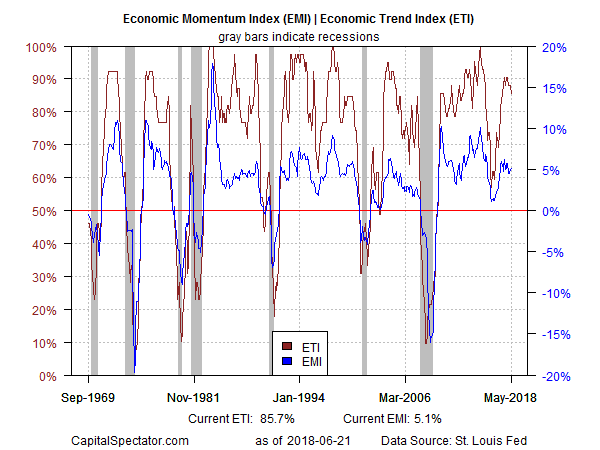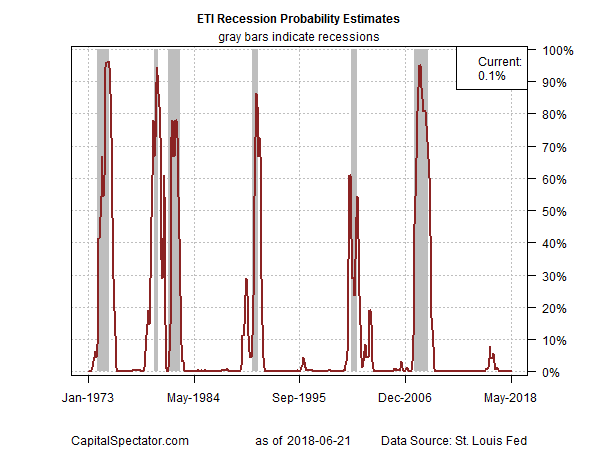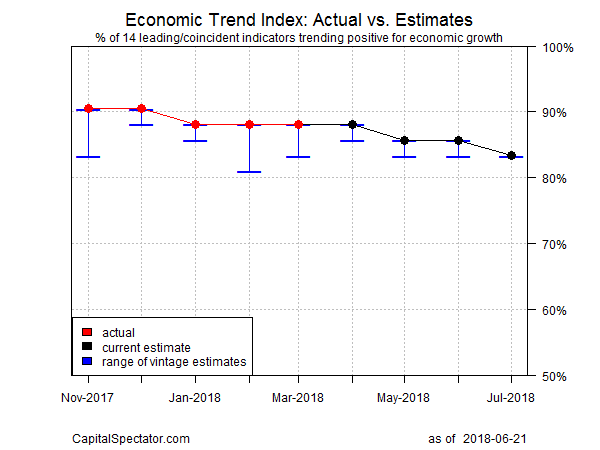The risk of trade war with China may be lurking, but for now the US macro trend remains healthy. A broad set of indicators continue to reflect low recession risk and a revised forecast for the business cycle suggests more of the same through next month.
The current economic profile strongly suggests that the upbeat macro analysis for the US will be reaffirmed in the May report of the Chicago Fed National Activity Index (CFNAI), which is scheduled for release on Monday (June 25). Numbers published to date point to a strong likelihood that CFNAI’s three-month average will hold well above the -0.70 mark that signals the start of downturns.
If there’s a risk factor that could change the rosy calculus in the months ahead, rising tension over trade between the world’s two largest economies is on the short list. Mark Zandi, chief economist of Moody’s Analytics, today warns that “President Trump has taken us into a global trade war.”
He thinks he can win the war, but he is wrong. The best we can hope for is that he figures this out quickly, limiting the economic damage. I’m increasingly worried that he won’t.
It’s unclear at this point how much of a threat this risk poses for the US economy. Much depends on policy decisions in Washington and Beijing in the weeks ahead. But at the moment there’s no sign of trouble for US growth via the numbers in hand. As discussed earlier this week, current estimates for the rise in GDP is on track for a solid acceleration in the second quarter report that’s due next month.
Meanwhile, The Capital Spectator estimates a near-zero chance that a new NBER-defined downturn started in May, based on a diversified set of economic indicators. (For a more comprehensive review of the macro trend with weekly updates, see here.)
Aggregating the data in the table above translates into a strong positive trend overall. The Economic Trend and Momentum indices (ETI and EMI, respectively) remain well above their respective danger zones (50% for ETI and 0% for EMI). When/if the indexes fall below those tipping points, the declines will mark clear warning signs that recession risk is elevated and a new downturn is imminent. The analysis is based on a methodology that’s profiled in my book on monitoring the business cycle.
Translating ETI’s historical values into recession-risk probabilities via a probit model also points to low business-cycle risk for the US through last month. Analyzing the data in this framework indicates that the odds remain effectively zero that NBER will declare May as the start of a new recession.
For the near-term outlook, consider how ETI may evolve as new data is published. One way to project values for this index is with an econometric technique known as an autoregressive integrated moving average (ARIMA) model, based on calculations via the “forecast” package in R. The ARIMA model calculates the missing data points for each indicator for each month — in this case through July 2018. (Note that March 2018 is currently the latest month with a complete set of published data for ETI.) Based on today’s projections, ETI is expected to remain well above its danger zone through next month.
Forecasts are always suspect, but recent projections of ETI for the near-term future have proven to be reliable guesstimates vs. the full set of published numbers that followed. That’s not surprising, given ETI’s design to capture the broad trend based on multiple indicators. Predicting individual components, by contrast, is subject to greater uncertainty. The assumption here is that while any one forecast for a given indicator will likely be wrong, the errors may cancel out to some degree by aggregating a broad set of predictions. That’s a reasonable view, based on the generally accurate historical record for the ETI forecasts in recent years.
The current projections (the four black dots in the chart above) suggest that the economy will continue to expand. The chart also shows the range of vintage ETI projections published on these pages in previous months (blue bars), which you can compare with the actual data (red dots) that followed, based on current numbers.




